Mailbag: What Type of Midfielder is Eduardo Camavinga?
An elite ball-winner who isn't a #6. A line-shattering stud who isn't much of a passer? Huh?
In the wake of the revelation that the Kylian Mbappé deal might not actually be happening, Real Madrid have finally detached themselves from their obsessive pursuit of a singular player to chase the variety of other options that roughly €200 million can buy.
Though yet to be official at the time of writing, all available news points to the fact that Madrid have turned their attention to Eduardo Camavinga and are only a few formalities away from presenting him at the Bernabéu. His age (18), reported price tag (€30 million+add-ons), and precocious ability have led to considerable excitement about what he can offer and develop into.
Those traits have also generated a lot of talk and, as a result, I’ve heard him likened to Xabi Alonso and Casemiro in the same breath and dubbed a pivot, volante, mezzala, six, eight, and everything in between. As sure as everyone is of his quality, there seems to be a wide-ranging set of opinions and misconceptions about his skillset and ideal role.
That probably needs some correcting, so, once again, using your questions, let’s try to gain some insight into another Real Madrid transfer target and sort out the specificities of Camavinga as a player.
The general consensus, which is that Camavinga is one of the best central midfield prospects in the world, is hard to disagree with. One of the simplest and most underrated ways to assess talent is to look at minutes played. At age 16, he racked up 2,107 minutes in a top 5 European League, followed up by 2,402 mins in 2020/21. That is very unlikely to happen to someone that young unless they are very good.
Statistically, Camavinga stands out as an incredible tackler, dribbler, and carrier.


It’s this rare combination of elite ball-winning and an exceptional ability to beat defenders at high success rates (something no Madrid central midfielder has together) that makes Camavinga such a star. That he is so masterful at two very valuable skills at age 18 means that he can contribute now while theoretically being able to grow into a more rounded product.
A quick look at some video reveals that the eye-test is reflective of his fbref resume.
Camavinga’s length, flexibility, and body control are the physical base for his tackling style. You can often see him hunch into a crab-like stance when facing an attacker barreling towards him, enlarging his zone of control. From there, his timing and targeting of the ball takes over; one leg will lash out and poke possession away.
It’s like watching a praying mantis snatch insects, except this mantis is a six-foot human being with awesome athleticism.
In situations that aren’t face-on, Camavinga stalks his prey with frightening calculation. He’ll use quick bursts to get within the vicinity of a dribbler before decelerating drastically and shortening his steps in preparation for an abrupt change in direction from the dribbler. As soon as the ball goes one way, his mantis limbs connect.
There’s simply no escape once the ex-Rennes midfielder gets within a certain distance of his food (hence, “zone of control”), even if you put him in your rearview mirror.
He’s simply too big, long, fast, and accurate to let someone get away, and possesses a subconscious understanding of angles. It’s not uncommon for Camavinga to usher players to the sideline or double up to pickpocket an opponent that is occupied with beating someone else.
His 1v1 supremacy makes him an incredible safety valve in transition and a proactive defender who can force the issue in more settled situations.
One suspects that Camavinga’s intuitive understanding of isolations — when melded with his physical qualities — helps him as a take-on specialist, as well.
Camavinga’s close control is admirable. Aided by his quick feet and quiver of step-overs, drag-backs, and nutmegs, he can navigate tight spaces better than most and poses an extinction-level threat to pressing actions.
However, his dribbling style is rather distinct from many of the figures associated with Houdini-level escapes (i.e. Isco, Iniesta, etc.). He will sometimes take bigger touches than one might expect in close quarters, encouraging a secondary or tertiary tackler to engage. Just like with his defending, Camavinga’s length comes to the rescue, pushing the ball away in the nick of time to retain possession.
This ‘baiting’ style is what allows him to pull off so many highlight-worthy sequences where he takes multiple defenders out of the equation. It does come with a certain degree of risk, but Camavinga’s tackling instincts tend to take over if he can’t fully avoid a challenge, enabling him to succeed through scruffier means if necessary.
The real issue is that he can be prone to dribbling somewhat aimlessly. He’ll take off without a clear objective and turn into spaces that aren’t beneficial for the team. His sheer skill ensures that he keeps hold of possession in these instances, but without actually destabilizing structures or providing a tactical advantage to his team.
It would be shocking if an 18-year-old gifted with the envious capacity to embarrass defenders wasn’t overzealous with it, and I would expect greater judiciousness to come with time.


Camavinga’s defensive ability and sexy offensive skills have caused considerable confusion over his best position. To put it simply, Camavinga is not a classic destroyer or anchorman. In fact, it was Steven N’Zonzi who approximated something closer to those roles in 2020/21, with Camavinga being the more adventurous partner, whether in a double pivot or as an interior in a three-man midfield.
Camavinga’s sparse interception figures stand in stark contrast to his voluminous tackling numbers and hint at his aggression out of possession. Indeed, he is eager to vacate his initial position to hunt for the ball and is well-suited to this due to the reasons outlined before.
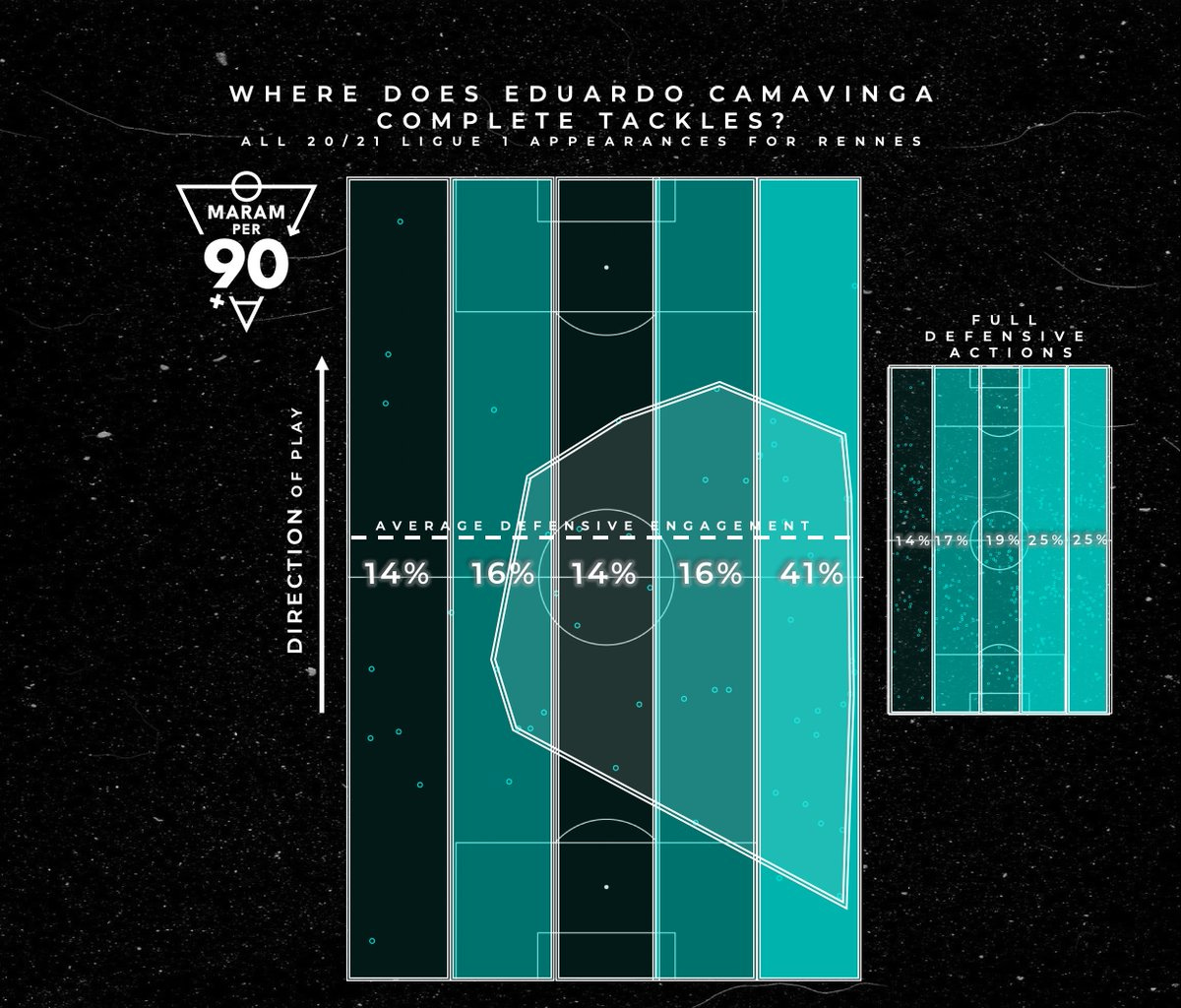
This stylistic quirk makes him the primary ball-winner for his side while being an odd fit as the type of screening presence associated with the traditional #6.
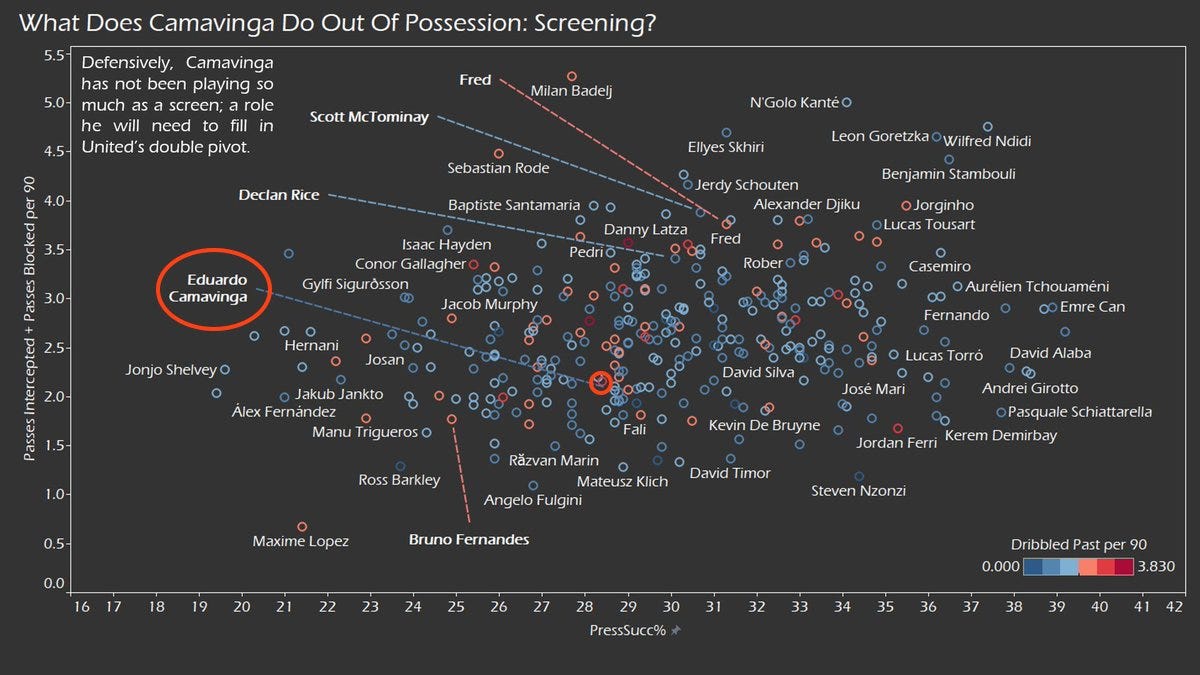
If he has a defensive flaw, it’s that he can disrupt his side’s compactness via his unquenchable thirst to make plays against the ball.
In possession, Camavinga is anything but a deep-lying playmaker, regardless of the weird comparisons to players of that ilk (he’s not a Modrić replacement either). His progressive passing is easily the biggest hole in his game.

Camavinga is overly conservative, tending to find the easy option on the wing above all else, and hardly switches play, ranking in the 27th percentile at 1.12 attempts p90.
His best passes come off the dribble, where he has broken lines to initiate combinations or opened up more obvious windows for vertical passes. After pouring through hours of film for this mailbag, nothing has given me the impression that he is a controlling, tempo-setting midfielder. Although his passing range and vision is certain to grow with time, I am very skeptical that his ceiling in these departments is high enough for him to ever be the hub of build-up play.
I suspect what tricks people is Camavinga’s desire to drop off and receive to feet. He is extremely active showing for the ball and displays a hunger to get touches. This gives him the veneer of an archetype built for dictating proceedings. Nonetheless, in lieu of making valuable passes from deep, he charges forward to engage defenders.
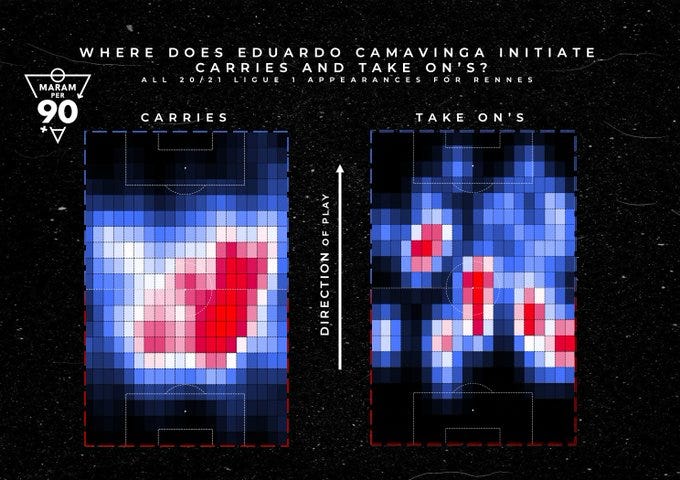
This is why Camavinga can come off as a “moments” player — rather quiet and unassuming in impact until he finds a way to make a dashing run with or without the ball.
Thus, Camavinga is best in faster-paced situations, where his reactions are more instinctive and he can leverage his dribbling and carrying. Someone else — like a Toni Kroos or Luka Modrić — needs to stand beside him to instill order and ensure that the team isn’t constantly operating at Camavinga’s preferred tempo.
In a way, he’s somewhat similar to N’Golo Kanté — a ball-winning genius that is most comfortable exchanging passes at breakneck speed and bursting forward in “box-to-box” fashion, although Camavinga’s press resistance and carrying is much superior to the Chelsea midfielder’s.
Other plausible comparisons might be Mousa Dembélé, Mateo Kovačić, Frenkie de Jong, Tanguy Ndombele, and Fernando Redondo (since someone asked) if we want to hone in on players who were and are carry-centric in their progression.
Again, these aren’t perfect matches — those five are all a step below defensively and better passers — outlining just how unique Camavinga’s makeup is. Few players max out in both tackling and dribbling while looking relatively pedestrian everywhere else.
Consequently, figuring out his best position can be quite tricky. It’s clear that he needs license to roam to enhance both his attacking and defending, but does that best occur in a double pivot or as an interior?
Camavinga would have more freedom to get forward as the latter in a vacuum, but his attraction to the ball keeps me from feeling that he’s optimized there. He’s better situated in a midfield two due to his sparse positioning between lines and desire to initiate in front of blocks, though he is still viable as an eight thanks to his secondary threat as a late runner.




Camavinga and Valverde don’t contrast enough to be paired together (the primary stylistic differences between them are Valverde’s minimal ball-dominance and discipline pressuring defenses with his advanced positioning). Both excel covering ground, carrying the ball, and recovering possession, but need a controller alongside them. An Eduardo-Fede midfield would be too chaotic.
It is true that both players enjoy featuring on the right side, but this is less of an issue than what’s just been discussed. Sure, while either one playing on the left might mess with some of the dynamics that Madrid have built on their favorite flank, the two of them are still fully capable of succeeding there. If forced to choose, I would put Fede on the left, since the opposite side provides better angles for Camavinga’s heavily one-footed style of dribbling.
Pairing Camavinga with Blanco in a double pivot makes a lot more sense based on my impressions of the latter as a passer, but I would be surprised to see the Castilla grad in the rotation given the midfield competition. Camavinga only complicates the selection picture despite arguably fitting well next to Blanco.
Nevertheless, I wouldn’t say this eliminates the possibility of Camavinga and Fede playing in the same eleven — it would just have to be with another midfielder next to them. Kroos as a pivot behind the duo is intriguing. The fullbacks could become crazy offensive, safe in the knowledge that two transition monsters have their backs, but I would say that the lack of creative passing in the interior spots dims my excitement of such a set-up.
So, what to do with Camavinga? He is probably seen as a Casemiro replacement by the board, which I don’t disagree with in a broad sense. Though a Kroos-Casemiro-Camavinga trio would work, the kid’s presence makes the Brazilian’s far less necessary. That doesn’t mean that Camavinga should operate as the six — rather that you can make room for someone else to take up Casemiro’s place as a pivot.
Suddenly, the debate over the trade-offs of starting vs. not starting Casemiro against sides who seek to exploit his poor press resistance disappear. Camavinga can provide security — albeit more aggressively and expansively — without being a liability on the ball.
Madrid would still need someone dedicated to shielding the back line and plugging lanes, but that is the type of defensive work Kroos is arguably more suited for (it would still require a bit of a mentality shift, as the German often triggered Madrid’s press by stepping out of midfield in the Zidane era) and it’s not like Camavinga never does that himself.
Camavinga is a massive coup for this reason alone, but ensuring the right environment for him remains a delicate balancing act. To recap: he’s neither a great passer nor particularly involved in creating chances and accrues most of his value by dribbling, carrying, and tackling. To get the best out of him, he needs the freedom to roam — in AND out of possession — while operating next to partners who shoulder the burden of distribution and shot facilitation.
Ultimately, I land on a Kroos-Camavinga double pivot as the best situation for him, with a Modrić-Kroos-Camavinga midfield three being the second best option. I have the shrinking feeling that we might try him as a #6 given Isco’s emerging role and Valverde’s presence, but that should be an absolute last resort to get him into the side.

One would think that this kills the Asensio at CM experiment, but it depends on how Carlo views Camavinga. If Ancelotti sees him as a traditional defensive midfielder, then it wouldn’t affect Asensio at all.
I forgot Ceballos existed to be honest. He doesn’t even have a squad number on Madrid’s official website, so I don’t imagine that signing another midfielder gives him a better shot at making it here.

#1.

Once we establish that pressing is primarily determined by team-wide coordination, I think that Camavinga can have a significantly positive impact on any intense defensive scheme. His aggression, ground coverage, and 1v1 skill make him ideal at stepping up to dispossess players and he can recover if beaten or has to reorganize into a deeper shape.
Additional reading/watching on Eduardo Camavinga:
Eduardo Camavinga – Scouting Report from spielverlagerung
Piece on Camavinga by Peter Munnelly from Scouted Football
Why does everyone want to sign Eduardo Camavinga? from TIFO Football
Data thread on Camavinga by Jamie Scott (@JamiescottUV)





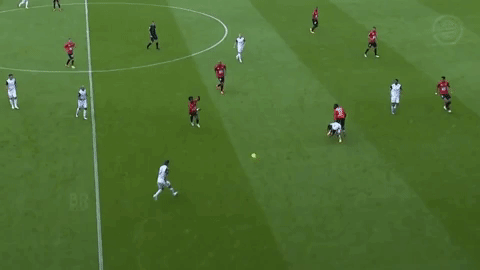
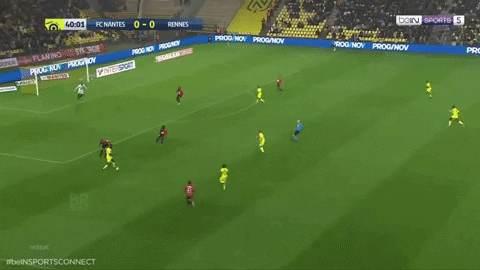






‘…although Camavinga’s press resistance and carrying is much superior to the Chelsea midfielder’s.‘
I highly doubt that as both are attributes that people tend to overlook in Kante. He’s capable of doing both at a very high level.
I had similar thoughts regarding his incompatibility with Valverde. I don't know if pushing Fede out to the right as a Di Maria-style inside-leaning winger might work, but I remember he's been tried out on the wing a few times before including during his loan spell at Depor.